Hydrological Modeling in Northern Tunisia with Regional Climate Model Outputs: Performance Evaluation and Bias-Correction in Present Climate Conditions
Abstract
:1. Introduction
2. Study Area and Data
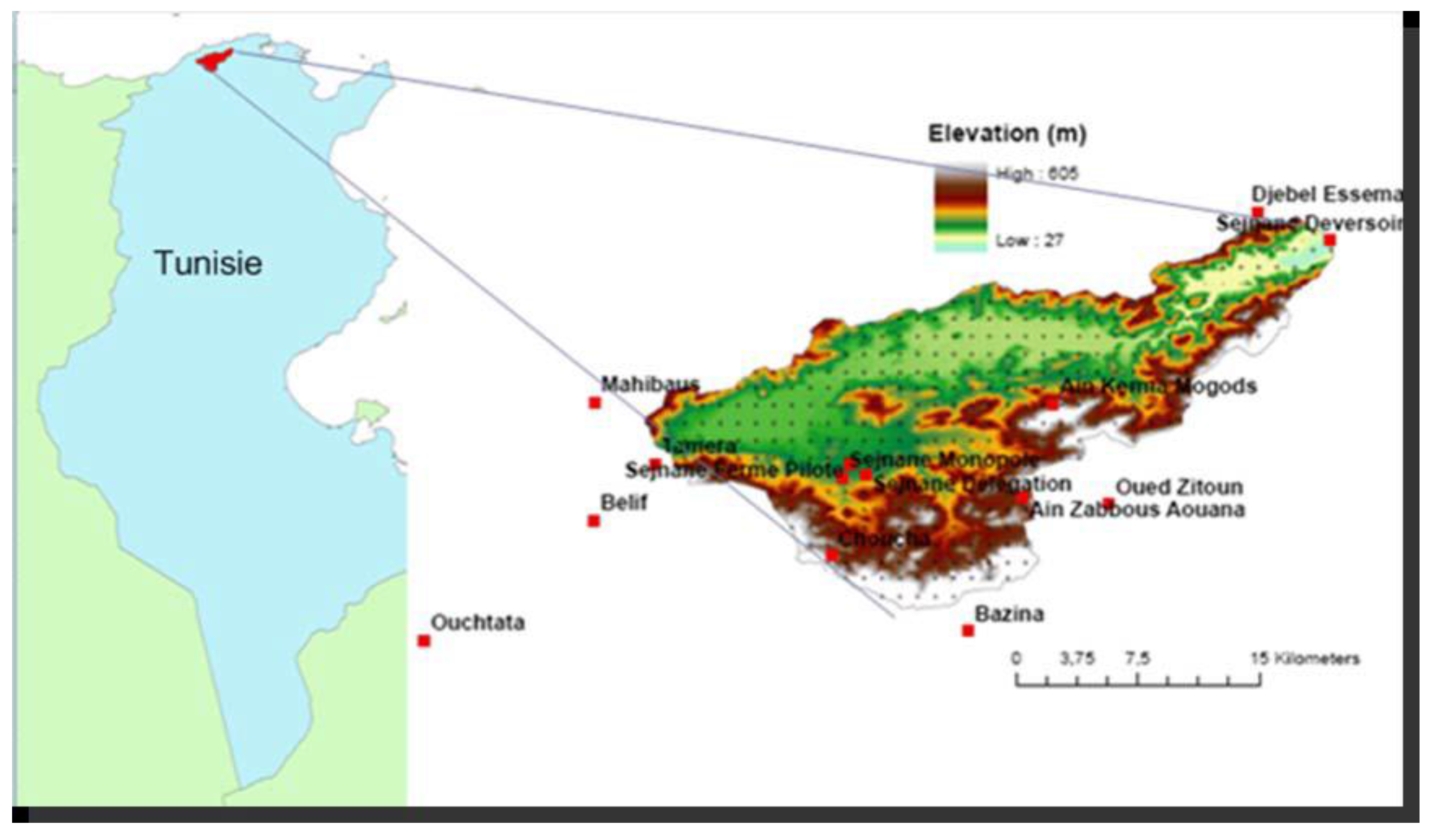
2.1. Ground Hydro-Climatic Data
2.2. Regional Climate Models Data
3. Methodology
3.1. Hydrological Modeling
3.2. RCM Outputs Evaluation
3.3. Correction of the RCM outputs
3.4. Drizzle Day Correction
4. Results
4.1. Hydrological Model Calibration Result Using Ground Data
| η | σ | Monthly RMSE (Calibration) | Decadal RMSE (Calibration) | Monthly RMSE(Validation) | Decadal RMSE (Validation) |
|---|---|---|---|---|---|
| 0.53 | 0.14 | 14.7 | 3.1 | 15.9 | 3.3 |

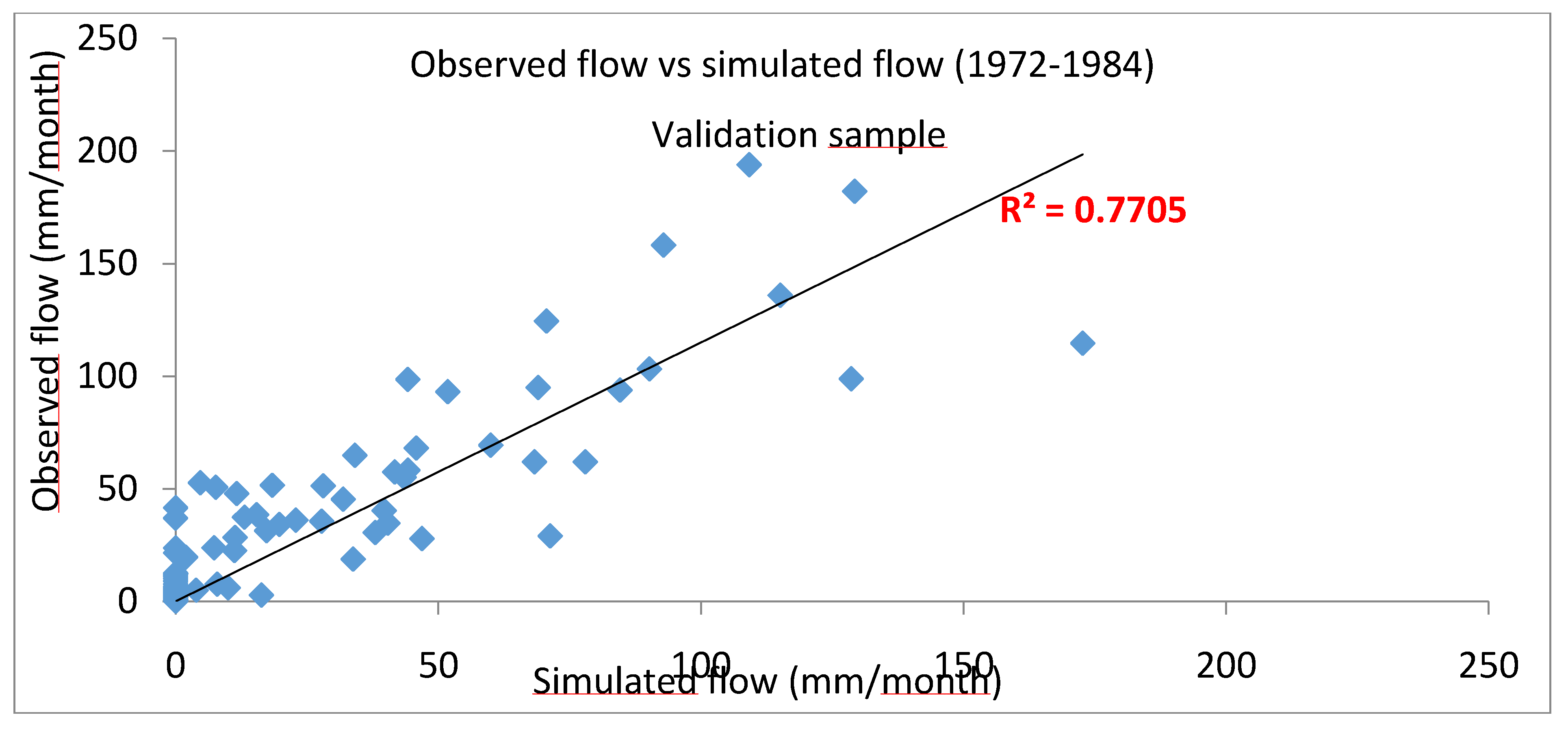
4.2. Evaluation of RCM Simulated Air Temperature
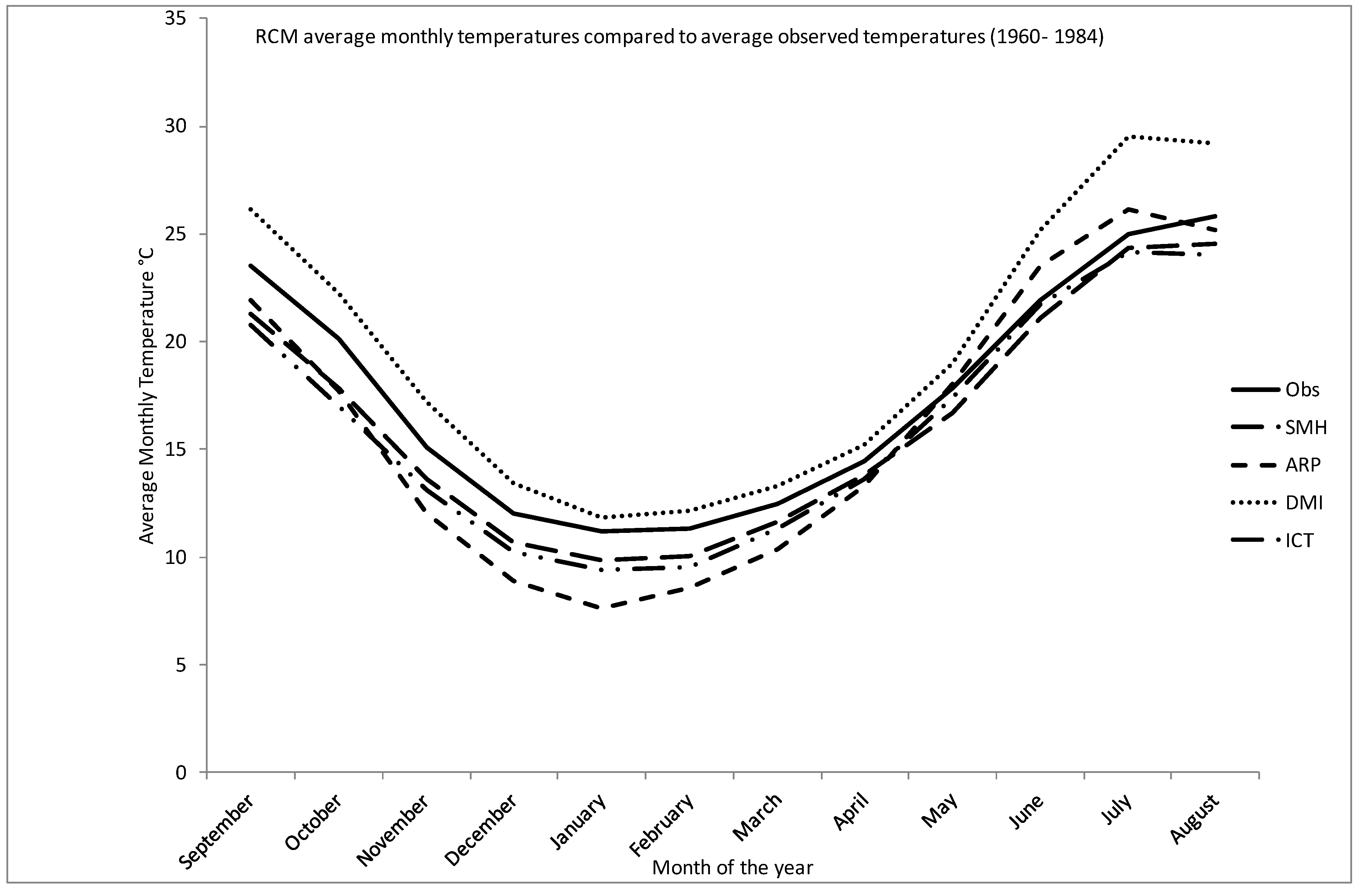
| Monthly Temp. Bias | SMH | ARP | DMI | ICT |
|---|---|---|---|---|
| September | 2.3 | 1.6 | −2.6 | 2.8 |
| October | 2.3 | 2.4 | −2.1 | 3.1 |
| November | 1.5 | 3.1 | −2.1 | 2.0 |
| December | 1.3 | 3.1 | −1.5 | 1.8 |
| January | 1.3 | 3.6 | −0.7 | 1.8 |
| February | 1.3 | 2.8 | −0.8 | 1.8 |
| March | 0.8 | 2.1 | −0.8 | 1.1 |
| April | 0.7 | 1.1 | −0.8 | 0.8 |
| May | 1.1 | −0.2 | −1.1 | 0.5 |
| June | 0.8 | −1.6 | −3.3 | 0.2 |
| July | 0.7 | −1.1 | −4.6 | 0.8 |
| August | 1.3 | 0.7 | −3.4 | 1.8 |
4.3. Evaluation of RCM Simulated Precipitation
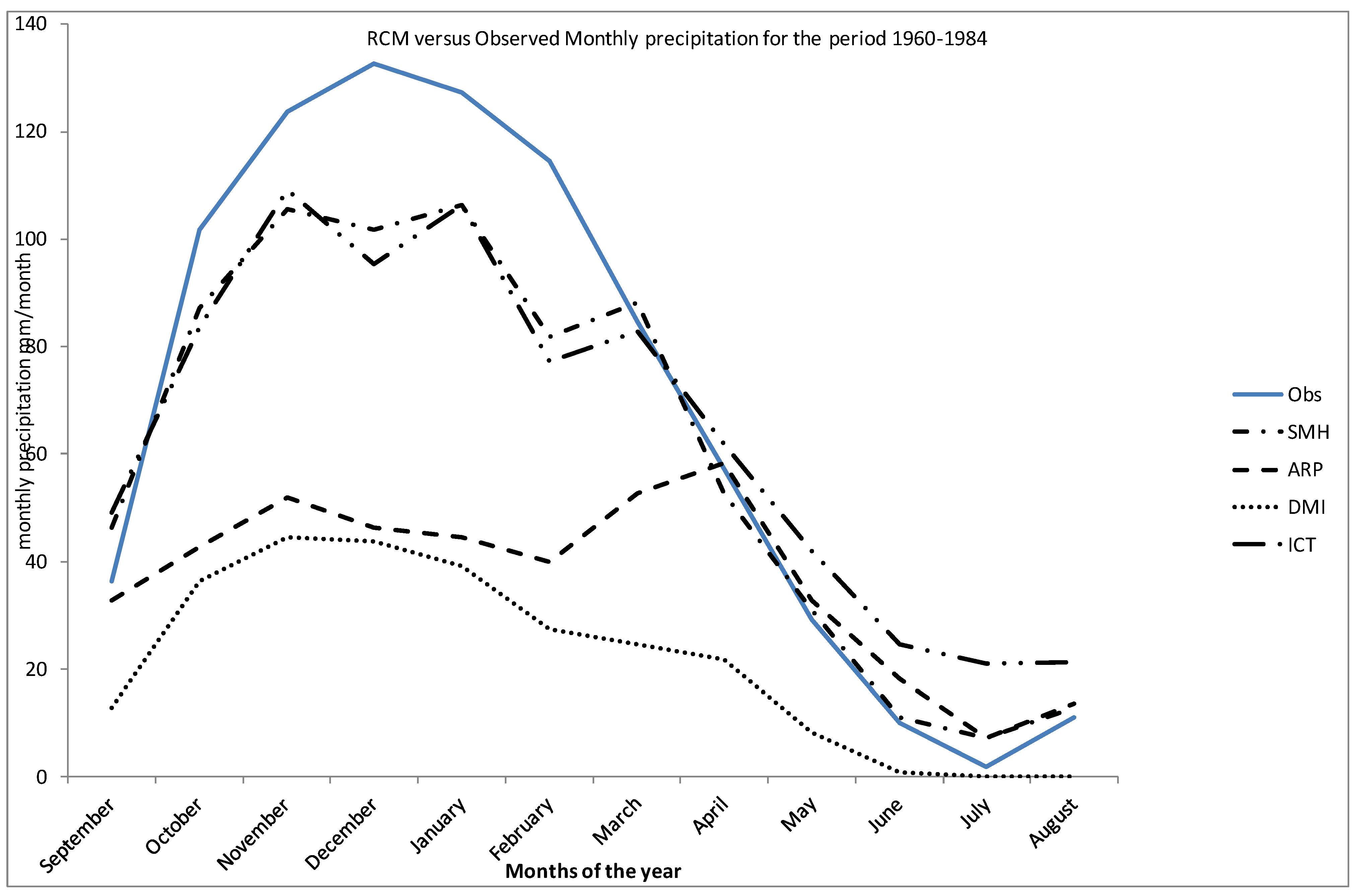
| Season | Observations | DMI | ICT | SMH | ARP |
|---|---|---|---|---|---|
| DJF | 44 | 0 | 13 | 22 | 0.4 |
| MAM | 62 | 0 | 18 | 39 | 0.8 |
| JJA | 92 | 0 | 43 | 69 | 0.3 |
| SON | 59 | 0 | 17 | 36 | 0.2 |
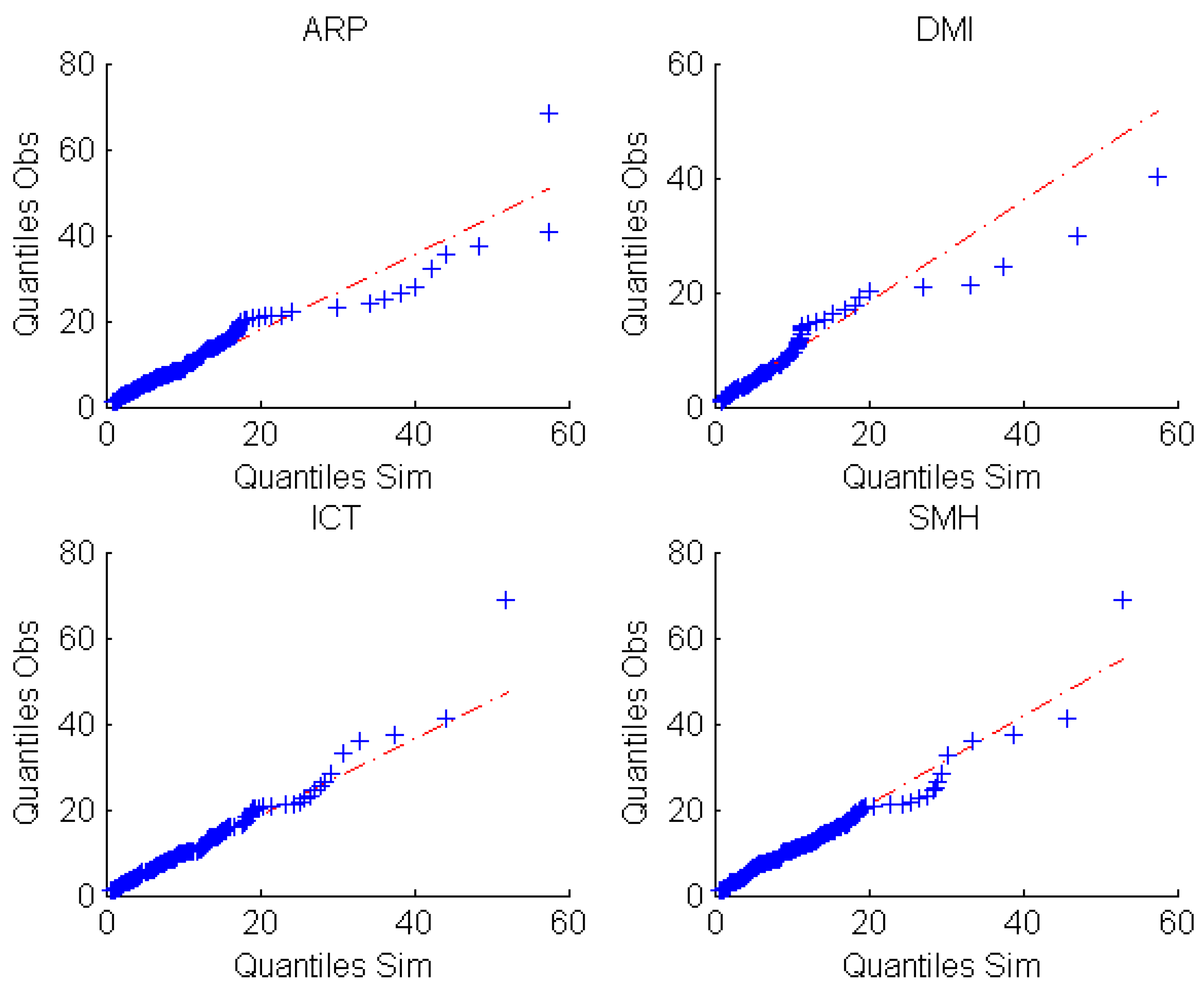
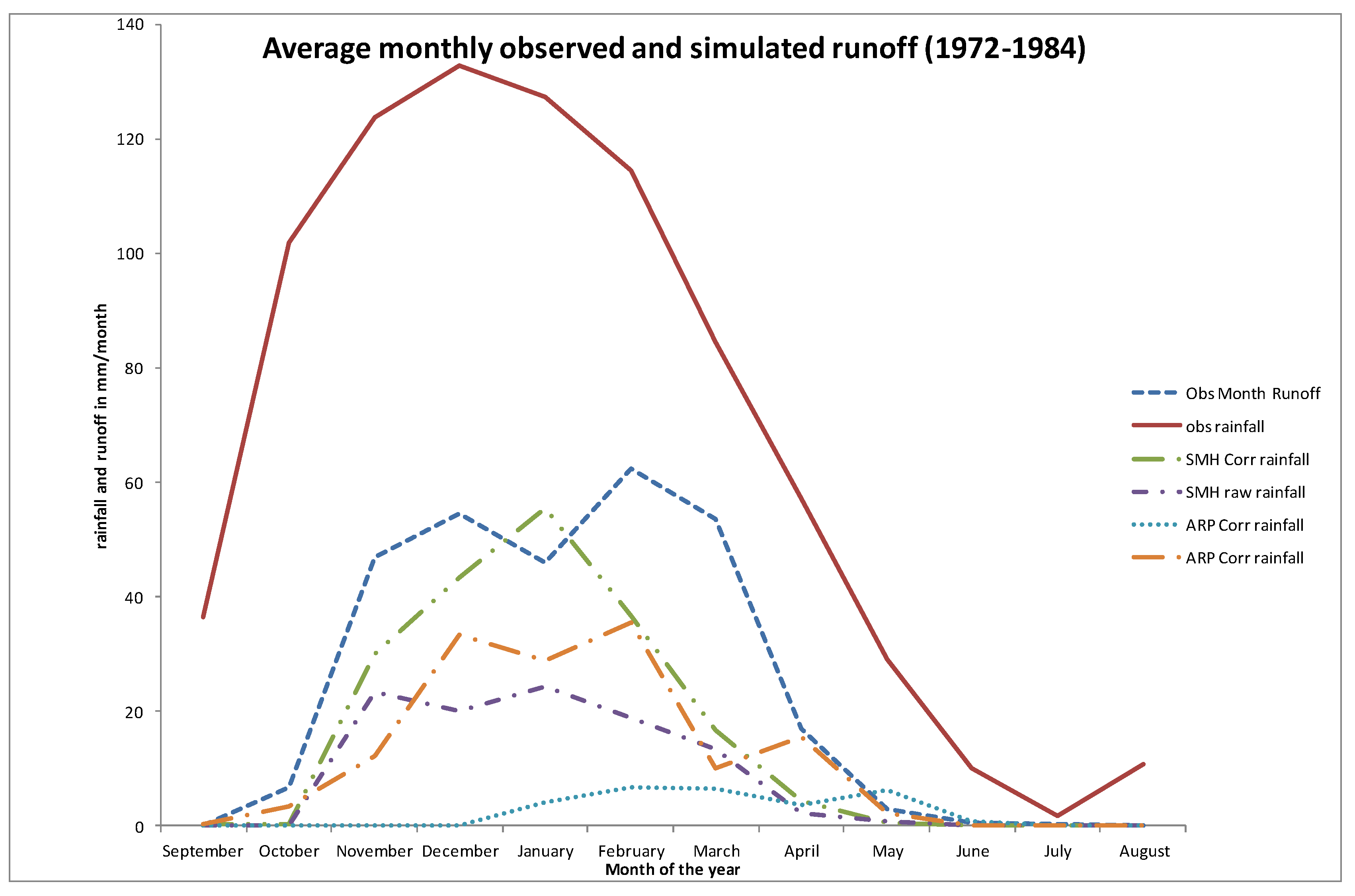
4.4. Hydrological Simulations Driven by Bias-Corrected RCM Precipitation Outputs
5. Conclusions
Acknowledgments
Author Contributions
Conflicts of Interest
References
- Giorgi, F.; Lionello, P. Climate change projections for the Mediterranean region. Glob. Planet. Chang. 2008, 63, 90–104. [Google Scholar] [CrossRef]
- Majone, B.; Bovolo, C.I.; Bellin, A.; Blenkinsop, S.; Fowler, H.J. Modeling the impacts of future climate change on water resources for the Gallego river basin (Spain). Water Resour. Res. 2012, 48, W01512. [Google Scholar] [CrossRef]
- Milano, M.; Ruelland, D.; Fernandez, S.; Dezetter, A.; Fabre, J.; Servat, E.; Fritsch, J.-M.; Ardoin-Bardin, S.; Thivet, G. Current state of Mediterranean water resources and future trends under global changes. Hydrolog. Sci. J. 2013, 58, 498–518. [Google Scholar] [CrossRef]
- Bargaoui, Z.; Tramblay, Y.; Lawin, E.; Servat, E. Seasonal precipitation variability in regional climate simulations over Northern basins of Tunisia. Int. J. Climatol. 2014, 34, 235–248. [Google Scholar] [CrossRef]
- Fowler, H.J.; Blenkinsop, S.; Tebaldi, C. Linking climate change modelling to impacts studies: Recent advances in downscaling techniques for hydrological modelling. Int. J. Climatol. 2007, 27, 1547–1578. [Google Scholar] [CrossRef]
- Peel, M.C.; Bloschl, G. Hydrological modelling in a changing world. Prog. Phys. Geogr. 2011, 35, 249–261. [Google Scholar] [CrossRef]
- Wilby, R.L. Evaluating climate model outputs for hydrological applications. J. Sci. Hydrol. 2010, 55, 1090–1093. [Google Scholar]
- Maraun, D.; Wetterhall, F.; Ireson, A.M.; Chandler, R.E.; Kendon, E.J.; Widmann, M.; Brienen, S.; Rust, H.W.; Sauter, T.; Themeßl, M.; et al. Precipitation downscaling under climate change: Recent developments to bridge the gap between dynamical models and the end user. Rev. Geophys. 2010, 48. [Google Scholar] [CrossRef]
- Jacob, D.; Barring, L.; Christensen, O.B.; Christensen, J.H.; de Castro, M.; Deque, M.; Giorgi, F.; Hagemann, S.; Hirschi, M.; Jones, R.; et al. An inter-comparison of regional climate models for Europe: Model performance in present-day climate. Clim. Chang. 2007, 81, 31–52. [Google Scholar]
- Hagemann, S.; Chen, C.; Haerter, J.O.; Heinke, J.; Gerten, D.; Piani, C. Impact of a statistical bias correction on the projected hydrological changes obtained from three GCMs and two hydrology models. J. Hydrometeorol. 2011, 12, 556–578. [Google Scholar] [CrossRef]
- Piani, C.; Weedon, G.P.; Best, M.; Gomes, S.M.; Viterbo, P.; Hagemann, S.; Haerter, J.O. Statistical bias correction of global simulated daily precipitation and temperature for the application of hydrological models. J. Hydrol. 2010, 395, 199–215. [Google Scholar] [CrossRef]
- Piani, C.; Haerter, J.O. Two dimensional bias correction of temperature and precipitation copulas in climate models. Geophys. Res. Lett. 2012, 39. [Google Scholar] [CrossRef]
- Themeßl, M.; Gobiet, A.; Leuprecht, A. Empirical-statistical downscaling and error correction of daily precipitation from regional climate models. Int. J. Climatol. 2011, 31, 1531–1544. [Google Scholar]
- Tramblay, Y.; Ruelland, D.; Somot, S.; Bouaicha, R.; Servat, E. High-resolution Med-CORDEX regional climate model simulations for hydrological impact studies: A first evaluation of the ALADIN-Climate model in Morocco. Hydrol. Earth Syst. Sci. 2013, 17, 3721–3739. [Google Scholar] [CrossRef]
- Kallel, M.R. Dossier Hydrométrique de l’oued Sejnane; Ministry of Agriculture and Water Resources: Tunis, Tunisie, 1980. [Google Scholar]
- United Nations Environment Programme-World Conservation M. Ichkeul National Park, Tunisia. 2008. Available online: http://www.eoearth.org/view/article/153760/ (accessed on 26 June 2013).
- Oudin, L.; Hervieu, F.; Michel, C.; Perrin, C.; Andréassian, V.; Anctil, F.; Loumagne, C. Which potential evapotranspiration input for a rainfall-runoff model? Part 2—Towards a simple and efficient PE model for rainfall-runoff modelling. J. Hydrol. 2005, 303, 290–306. [Google Scholar] [CrossRef]
- Climate Change and Its Impacts: Summary of Research and Results from the ENSEMBLES Project. Available online: http://www.ensembles-eu.org/ (accessed on 26 June 2013).
- Radu, R.; Déqué, M.; Somot, S. Spectral nudging in a spectral regional climate model. Tellus A 2008, 60, 898–910. [Google Scholar] [CrossRef]
- Christensen, J.H.; Christensen, O.B.; Lopez, P.; van Meijgaard, E.; Botzet, M. The HIRHAM4 regional atmospheric climate model. DMI Sci. Rep. 1996, 96, 51. [Google Scholar]
- Giorgi, F.; Mearns, L.O. Introduction to special section: Regional climate modeling revisited. J. Geophys. Res.: Atmos. 1999, 104, 6335–6352. [Google Scholar] [CrossRef]
- Kjellström, E.; Barring, L.; Gollvik, S.; Hansson, U.; Jones, C.; Samuelsson, P.; Rummukainen, M.; Ullersig, A.; Willen, U.; Wyser, K. A 140-year Simulation of European Climate with the New Version of the Rossby Centre Regional Atmospheric Climate Model (RCA3); SMHI: Norrkoping, Sweden.
- Kobayashi, T.; Matsuda, S.; Nagai, H.; Teshima, J. A bucket with a bottom hole (BBH) model of soil hydrology. In Soil-Vegetation-Atmosphere Transfer Schemes and Large-Scale Hydrological Models; Dolman, A.J., Hall, A.J., Kavvas, M.L., Oki, T., Pomeroy, J.W., Eds.; IAHS Press: Wallingford, UK, 2001; pp. 41–75. [Google Scholar]
- Bargaoui, Z.; Houcine, A. Sensitivity to calibration data of simulated soil moisture related drought indices. Rev. Sécher. 2010, 21, 294–300. [Google Scholar]
- Cosby, B.J.; Hornberger, G.M.; Clapp, R.B.; Ginn, T.R. A statistical exploration of the relationships of soil moisture characteristics to the physical properties of soils. Water Resour. Res. 1984, 20, 682–690. [Google Scholar] [CrossRef]
- Eagleson, P.S. Climate, soil, and vegetation 6. Dynamics of the annual water balance. Water Resour. Res. 1978, 14, 749–764. [Google Scholar] [CrossRef]
- Eagleson, P.S. The evolution of modern hydrology (from watershed to continent in 30 years). Adv. Water Resour. 1994, 17, 3–18. [Google Scholar] [CrossRef]
- Darling, D.A. The Kolmogorov-Smirnov, Cramér-von Mises tests. Ann. Math. Stat. 1957, 28, 823–838. [Google Scholar] [CrossRef]
- Déqué, M. Frequency of precipitation and temperature extremes over France in an anthropogenic scenario: Model results and statistical correction according to observed values. Glob. Planet. Chang. 2007, 57, 16–26. [Google Scholar] [CrossRef]
- Michelangeli, P.A.; Vrac, M.; Loukos, H. Probabilistic downscaling approaches: Application to wind cumulative distribution functions. Geophys. Res. Lett. 2009, 36, L11708. [Google Scholar] [CrossRef]
- Vrac, M.; Drobinski, P.; Merlo, A.; Herrmann, M.; Lavaysse, C.; Li, L.; Somot, S. Dynamical and statistical downscaling of the French Mediterranean climate: Uncertainty assessment. Nat. Hazards Earth Syst. Sci. 2012, 12, 2769–2784. [Google Scholar] [CrossRef] [Green Version]
- Lavaysse, C.; Vrac, M.; Drobinski, P.; Lengaigne, M.; Vischel, T. Statistical downscaling of the French Mediterranean climate: Assessment for present and projection in an anthropogenic scenario. Nat. Hazards Earth Syst. Sci. 2012, 12, 651–670. [Google Scholar] [CrossRef] [Green Version]
- Li, C.; Sinha, E.; Horton, D.E.; Diffenbaugh, N.S.; Michalak, A.M. Joint bias correction of temperature and precipitation in climate model simulations. J. Geophys. Res. Atmos. 2014. [Google Scholar] [CrossRef]
© 2015 by the authors; licensee MDPI, Basel, Switzerland. This article is an open access article distributed under the terms and conditions of the Creative Commons Attribution license (http://creativecommons.org/licenses/by/4.0/).
Share and Cite
Foughali, A.; Tramblay, Y.; Bargaoui, Z.; Carreau, J.; Ruelland, D. Hydrological Modeling in Northern Tunisia with Regional Climate Model Outputs: Performance Evaluation and Bias-Correction in Present Climate Conditions. Climate 2015, 3, 459-473. https://doi.org/10.3390/cli3030459
Foughali A, Tramblay Y, Bargaoui Z, Carreau J, Ruelland D. Hydrological Modeling in Northern Tunisia with Regional Climate Model Outputs: Performance Evaluation and Bias-Correction in Present Climate Conditions. Climate. 2015; 3(3):459-473. https://doi.org/10.3390/cli3030459
Chicago/Turabian StyleFoughali, Asma, Yves Tramblay, Zoubeida Bargaoui, Julie Carreau, and Denis Ruelland. 2015. "Hydrological Modeling in Northern Tunisia with Regional Climate Model Outputs: Performance Evaluation and Bias-Correction in Present Climate Conditions" Climate 3, no. 3: 459-473. https://doi.org/10.3390/cli3030459





